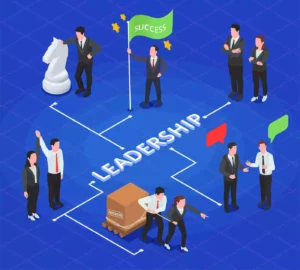In a business world that is constantly and just as rapidly evolving with each year, it has become crucial for effective leaders to be transparent.
Transparent leadership in its essence is an approach to management that puts an emphasis and importance on open communication and accountability.
This kind of leadership style creates an environment and culture that involves trust between employees. Decisions are made ethically while considering several perspectives.
Transparency also contributes to increase in employee engagement, thereby ensuring long-term success.
These leaders understand the importance of sharing information openly while also admitting to making mistakes. This encourages accountability withing the workplace.
Employees feel valued, respected and furthermore even empowered to contribute to the company in the best way possible.
The Key Aspects
- Open communication: Transparent leaders encourage two-way dialogue, actively listen to feedback, and share information openly with their teams and across the organization.
- Honest feedback: They provide candid and constructive feedback, admit mistakes and failures, and are open to receiving honest feedback themselves.
- Building trust: By being transparent and authentic, transparent leaders build trust and credibility with their teams, fostering an environment where people feel safe to take risks and voice their opinions.
- Clear expectations and accountability: Transparent leaders set clear expectations, hold themselves and others accountable, and take responsibility for their actions and decisions.
Importance in today’s workplace
In today’s rapidly changing business landscape, transparent leadership has become increasingly important for several reasons:
Attracting and retaining talent: Employees, especially younger generations, value transparency, authenticity, and open communication in the workplace. Transparent leadership can help organizations attract and retain top talent.
Fostering innovation: By creating an environment of trust and psychological safety, transparent leadership encourages employees to take risks, think creatively, and share ideas, which can drive innovation.
Building resilience: When faced with challenges or crises, transparent leaders can navigate through uncertainty more effectively by communicating openly, maintaining trust, and adapting to changing circumstances.
Enhancing reputation: Transparent organizations are perceived as more ethical, trustworthy, and socially responsible, which can improve their reputation and relationships with stakeholders.
In today’s workplace, where trust, engagement, and agility are critical for success, transparent leadership has emerged as a powerful approach to fostering a positive and productive organizational culture.
Strategies for Implementation
Leading by example
Transparent leaders must walk the talk and embody the values they preach. By being open, honest, and transparent in their own actions and communication, they set the tone for the entire organization.
This means being willing to share information, admit mistakes, and be accountable for their decisions. When leaders lead by example, they inspire trust and credibility, making it easier for others to embrace transparency.
Encouraging open dialogue
Transparent leadership thrives on open and honest communication. Leaders should create an environment where employees feel comfortable voicing their opinions, concerns, and ideas without fear of retribution.
This can be achieved by actively listening, asking questions, and genuinely considering different perspectives. Regular team meetings, town halls, and one-on-one conversations can foster an open dialogue, enabling transparent decision-making and problem-solving.
Sharing information openly
Transparent leaders understand the importance of sharing relevant information with their teams and stakeholders.
This includes providing regular updates on the company’s performance, challenges, and future plans. By being proactive in sharing information, leaders build trust and alignment, ensuring that everyone is working towards the same goals.
However, it’s crucial to balance transparency with discretion, protecting confidential or sensitive information as necessary.
Admitting mistakes and failures
No organization or leader is perfect, and transparent leaders acknowledge this reality. By openly admitting mistakes and failures, leaders demonstrate humility, accountability, and a willingness to learn and improve.
This approach not only builds trust but also encourages others to be transparent about their own shortcomings, fostering a culture of continuous improvement and learning from past experiences.
Developing Transparent Leadership Skills
Self-awareness and emotional intelligence
Transparent leadership starts with self-awareness and emotional intelligence. Leaders who are self-aware understand their strengths, weaknesses, values, and emotions, and how these factors influence their behavior and decision-making.
They are also able to recognize and manage their emotions effectively, which is crucial for building trust and maintaining open communication with their team.
Emotionally intelligent leaders are better equipped to understand and respond to the emotions of others, creating a more positive and supportive work environment.
They can empathize with their team members, acknowledge their concerns, and provide appropriate support and guidance.
This fosters a culture of transparency, where employees feel comfortable expressing their thoughts and feelings without fear of judgment or retaliation.
Active listening and communication
Effective communication is at the heart of transparent leadership. Active listening is a critical skill that allows leaders to truly understand the perspectives and concerns of their team members.
By actively listening, leaders can gather valuable insights, identify potential issues, and address them proactively.
Clear and open communication is also essential for fostering transparency. Transparent leaders share information openly and honestly, providing context and rationale for their decisions.
They encourage two-way dialogue, soliciting feedback and input from their team members, and addressing concerns or questions openly and directly.
Transparent leaders also communicate consistently and regularly, keeping their team informed about important developments, changes, or challenges facing the organization.
This helps build trust and alignment, as employees feel valued and included in the decision-making process.
Building trust and credibility
Trust and credibility are the foundations of transparent leadership. Leaders who demonstrate integrity, authenticity, and consistency in their words and actions are more likely to earn the trust and respect of their team members.
Transparent leaders build trust by being accountable for their decisions and actions, admitting mistakes or failures, and taking responsibility for their part in them.
They are also transparent about their own limitations and vulnerabilities, which can help humanize them and make them more relatable to their team.
Credibility is established by following through on commitments, delivering on promises, and maintaining a consistent set of values and principles.
Transparent leaders align their actions with their stated values and beliefs, demonstrating their authenticity and commitment to transparency.
Continuous learning and adaptability
Transparent leadership requires a commitment to continuous learning and adaptability. The business landscape is constantly evolving, and leaders must be willing to adapt and evolve their strategies, approaches, and mindsets accordingly.
Transparent leaders are open to feedback and new perspectives, seeking out opportunities to learn and grow. They are willing to challenge their own assumptions and biases, and they encourage their team members to do the same.
This creates an environment of continuous improvement and innovation, where new ideas and solutions can be explored and implemented.
Adaptability is also crucial for navigating the challenges and uncertainties that arise in the workplace.
Transparent leaders are agile and flexible, able to pivot and adjust their approach as needed, while maintaining open communication and transparency with their team.
Closing Thoughts
A leadership strategy like transparent leadership, which is unlike the hierarchical and traditional form of leadership, takes time to master and implement.
Employing this strategy means leaders must be open to criticism and commit to continuously learn from their environments.
When leaders are willing to adapt to their surroundings while also seeking to improve their skills and knowledge based on their requirements, they create an environment that inspire other employees to do the same.
Transparent leaders create a workplace culture where learning is encouraged. Moreover, this also provides employees with opportunities for further development in their careers.
The road to embodying effective leadership that works for both the organization or brand as well as the workplace culture is an ongoing journey.
Leaders can cultivate transparent leadership by developing skills and educating themselves on different strategies.





